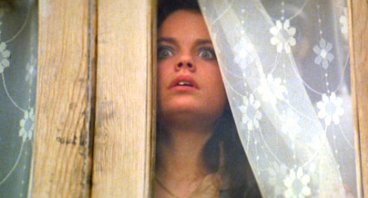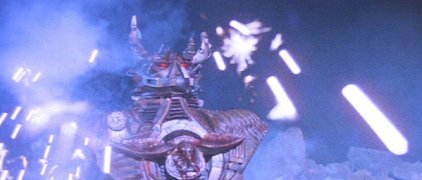Antony I Ginnane

See also
- Australian film
- drive-ins
- exploitation
- film production
- genre
- horror
- marketing
- producers
- screen violence
Related people
Related events
Richard Kuipers profiles the most prolific and outspoken of Australian producers, Antony I Ginnane.
I didn’t want to put audiences to sleep, I wanted to wake them up.
Antony I Ginnane in Not Quite Hollywood (2008)
We have spent over $1 billion on our film industry since the 1970s, but we have never stood together and said, 'This is an industry. This is a business. It is not about art. It is not for dilettantes.’
Antony I Ginnane, in conversation with australianscreen, 16 September 2009
If Australian cinema has an equivalent of American B-movie king Roger Corman, it’s Antony I Ginnane. A producer and executive producer with more than 60 feature, telemovie and mini-series credits since 1976, Ginnane is one of Australia’s most prolific and successful producers-executive producers and one of its most outspoken. Although best known for a run of highly commercial genre pictures including Fantasm (1976), Patrick (1978), Thirst (1979) and Turkey Shoot (1982), Ginnane’s resume also includes prestige items such as Grievous Bodily Harm (1988) and Gillian Armstrong’s High Tide (1987). Currently the president of SPAA and still very active (15 films as producer or executive producer since 2000), Ginnane featured prominently in the documentary Not Quite Hollywood (2008), a look at Australian exploitation movies of the 1970s and ‘80s. One of his biggest fans is Quentin Tarantino (see Not Quite Hollywood, 2008, clip two).
Born in Melbourne in 1949, Ginnane developed a strong interest in cinema while studying law at Melbourne University. In conversation with australianscreen he recalls:
I managed to write, produce and direct a black-and-white 16mm feature, Sympathy in Summer (1970), while at university and in my final year of law (1975) I put a finance package together for Fantasm (1976). Between 1970 and 1975 I’d been to Cannes (and other festivals) each year; consulted on The True Story of Eskimo Nell (1975) for Richard Franklin; published a film magazine, Film Chronicle; run a bunch of retrospectives (Carl Dreyer, Jean-Luc Godard, Robert Bresson) and started a little film distribution company.
Ginnane completed his degree and was admitted to the Victorian Bar but, with showbiz beckoning, ‘Law didn’t really stand a chance’. His distribution company, Studio Films, imported both grindhouse horrors and art-house attractions such as Godard’s Wind from the East (1970). ‘Three Fassbinders plus one The Corpse Grinders (1972) was the formula’, he remembers.
Ginnane packaged and promoted his titles with considerable flair. When the softcore sex-horror movie The Vampire Happening (1971) screened at drive-ins on Friday the thirteenth, suggestions in the publicity kit given to exhibitors included giving free admission to cars with number plates ending in 13 (one can just imagine people cramming into car boots once word got out!). Of his time running Studio Films (in partnership with Brian Davis from the Grand Cinema in Footscray) Ginnane says:
I learned the basics of exploitation and distribution – writing trailers, ad copy and spending a lot of time with independent exhibitors. You learned the mechanics of profit margin and the film industry money waterfall. When you made money for the independent exhibitors they wanted you back. I guess I balanced the art versus commerce dichotomy better than most and earlier than most.
Fantasm (1976) was a softcore sex omnibus directed by Richard Franklin under the name ‘Richard Bruce’ and filmed almost entirely in Los Angeles. Made for $50,000 on 16mm and featuring legendary American adult film stars Rene Bond, Uschi Digard and John Holmes, it proved a spectacular success, grossing over $650,000 in Australia alone. ‘It was exploitation at its best … we were young and frisky’, says Ginnane on the DVD extras of Fantasm (1976). A sequel, Fantasm Comes Again (1977), also turned a tidy profit.
In 1977 Ginnane became a director of Australian International Film Corporation, a company set up by local distributor-production entity Filmways. AIFC’s first project was the family film Blue Fire Lady (1977), starring pop singer Mark Holden and UK import Cathryn Harrison (daughter of Rex Harrison). Its disappointing returns prompted Ginnane’s return to genre material. Patrick (1978) was the result. A polished supernatural horror directed by Richard Franklin, it sold well overseas, even inspiring an unauthorised Italian ‘sequel’ Patrick Vive Ancora (1980, AKA Patrick is Still Alive).
Ginnane believed Australia needed to internationalise its film industry and regularly hired overseas actors as part of a strategy to boost foreign sales potential. To what degree British performer Susan Penhaligon helped Patrick (1978) into UK cinemas or David Hemmings and Henry Silva assisted Thirst (1979) in the international marketplace is debatable, but what is beyond question is Ginnane’s track record for selling his pictures offshore. His efforts didn’t stop at having foreign cast members. Australian place names were rarely mentioned, and the mystery-thriller Harlequin (1980) was decorated to look as if it could have been made in the US.
Most of Ginnane’s films indeed performed better overseas than at the local box office. Believing that Americans were much more adept with genre material, Australian audiences did not much embrace home-grown horror-thrillers until Wolf Creek (2005). A good example is Snapshot (1979), which was barely released domestically yet notched up solid international sales and played in the US under the supremely misleading title The Day Before Halloween (1979).
Without doubt the most controversial Ginnane production is Turkey Shoot (1982). A bloodthirsty riff on The Most Dangerous Game, Richard Connell’s 1924 short story about hunting humans for sport, it still boggles the mind as to how how this film avoided the 'R’ (restricted to 18 and over) censorship rating. In his book The Avocado Plantation (1990, Pan Macmillan), David Stratton described it as ‘a catalogue of sickening horrors.’
Ginnane productions of the 1980s include Rolf de Heer’s sci-fi mystery Incident at Raven’s Gate (1988), Simon Wincer’s big-budget war story The Lighthorsemen (1987), Don McLennan’s family drama Mull (1989) and Dark Age (1987), a killer crocodile picture directed by Arch Nicholson. Dark Age (1987) is a personal favourite of Quentin Tarantino, who brought his own 35mm print to Sydney and hosted a screening during his promotional tour for Inglourious Basterds (2009). Ginnane was also involved in The Time Guardian (1987), Australia’s first attempt at special effects-driven sci-fi action for the international market.
The Australian film revival had been underway less than a decade when Ginnane came to prominence. Production had risen dramatically since the ‘lost decade’ of the 1960s but Australian cinema was still a small player on the world stage and relied heavily on government support, as it continues to. Many in the industry supported the requirement for productions to contain ‘significant Australian content’ to benefit from tax incentives. Central to this policy was ensuring that Australian culture was represented on screen. Ginnane disagreed strongly.
At a debate at Murdoch University in Perth in October 1983, he said that ‘during the past 10 or 15 years the term “significant Australian content” … was to become the mallet by which the legs of a commercial, free enterprise film industry were broken time and time again. Many Australians refuse to admit that a very significant part of Australian culture overlays, and is identical to, American culture. From McDonalds, to Coca-Cola and Star Wars: these are the frames of reference for today’s cinema audience.’ Phillip Adams, the film producer, cultural commentator and a long-standing opponent of Ginnane’s views, responded with ‘I will not tolerate, nor would I want to be a part of, a film industry which only made “mid-Pacific” films.’
Reflecting today on the debate that has raged since Australian cinema was born, Ginnane says:
In some ways, and at some levels, the battle for internationalism that put me at odds with [Actors] Equity, many government bureaucrats and some of my peers in the 1970s and early 1980s, has been won. We have world-class studios in three States. We have a relatively competitive tax rebate geared to attracting major international productions. We have managed to make the 'significant Australian content’ rules more realistic and have removed 'co-production’ from the lingua non grata of the [government funding] agencies.
Involved in the packaging, marketing and licensing of international film and television productions through his Los Angeles-headquartered company IFM World Releasing since the mid-'90s, Ginnane returned to Australia in 2008. Elected president of SPAA and resuming his domestic producing activities, Ginnane remains as outspoken as ever. ‘We clamber for commercial success and when it eludes us – not surprising given the content of much of our output – we fall back on the incestuous 'troika of critics, film festivals and cultural commissars for our justification. We confuse internationalism with Americanism and then chant the “Australian voices” mantra like some reverse playback of the Red Flag.’ Of the small market share for Australian films at the domestic box office, he puts it bluntly: ‘No wonder we struggle to get to five per cent of the gross box office, let alone the ten per cent we should be easily obtaining’.
Numbering Patrick (1978), Harlequin (1980), Mesmerized (1986, Australia-New Zealand-UK) and Screamers (1995, US-Canada-Japan) among personal favorites of the films he’s made, Ginnane is virtually alone in being an Australian film producer who has spent the better part of four decades putting together deals around the globe. He has both admirers and detractors but what’s certain is that when Antony I Ginnane is around, things happen and movies get made.
External Links
Citations
- The Avocado Plantation: Boom and Bust in the Australian Film Industry (1990)
Stratton, David
Publisher: Pan Macmillan Australia, Sydney - The Last New Wave: The Australian Film Revival (1980)
Stratton, David
Publisher: Angus & Robertson, Sydney
- Titles
- Portrait
- Extras
- Screenography








